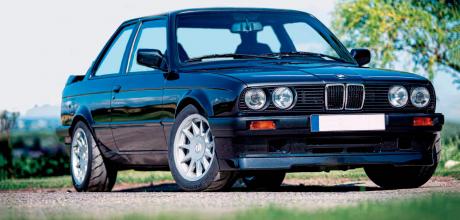933bhp S38B36 turbo engined BMW E30 Coupe
Deep Sleeper Looks can be deceiving. This innocent-looking E30 from the Czech Republic packs a serious 933hp punch! Words and Photographs: Robb Pritchard.
The «sleeper» E30 with 933hp!
When Viktor Zpevák first joined his local BMW club as a teenager he had the least powerful car in the group. It has been a long journey, but twenty years later he now has an E30 that is almost as powerful as an F1 racer.
Viktor’s life-long interest in BMW tuning began almost as soon as he’d passed his driving test, as it didn’t take him too long to get bored with his parent’s Skoda Fabia. With every last Czech koruna in his pocket he bought an old 318i, which compared to the family hatchback felt like a rocket. He loved it so much he joined the E30 Club of the Czech Republic, but it was there that he realised that his beloved new ride wasn’t quite so special after all, because literally everyone in the club had cars that were a lot more powerful than his. “I had to do something!” he laughs.
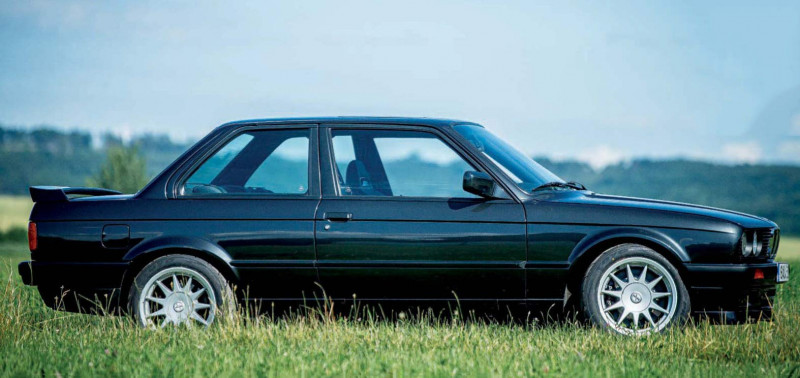
That something was buying an E21 and putting a turbo on it. Weighing just 1000kg and with 250 blown horsepower, that E21 wasn’t just a fun car, it was what set him on the way to creating the understated monster that now lurks in his garage. “Back in those days there were abandoned airports from the Soviet era in the area that we could drive and drift on them as much as we wanted as there was no organisation, no marshals, no safety, just a few friends.” But when some private people bought the airports, the E30 club had to become a little more ‘official’ and take their cars to do track days instead. Now, instead of just more power, Viktor and his friends needed cars that could handle well and stop properly… and so with a E24 635CSi biturbo he stripped-out, he learned about suspension set up and competition brakes.
The forward motion is simply brutal. Like a head-on accident in reverse...
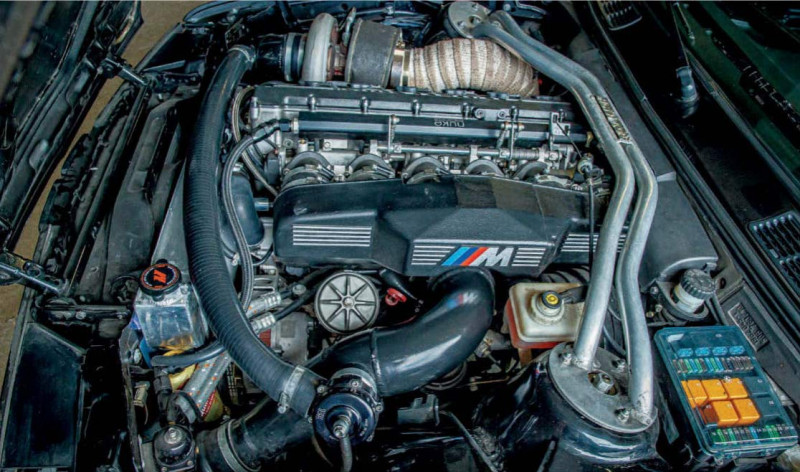
But every car he built had a turbo fitted. “Getting more power out of a naturally aspirated engine is very expensive. It works out that for every horsepower you increase by, it costs about £30. So a turbo is the quickest and cheapest way to make more power. But everything I did, I learned how to do it myself, from what parts to use, what compression to set it to, which turbo to start with. I spent many nights on the internet taking ideas and little bits of information from everywhere, the books written by Corky Bell were a great source of knowledge. But I also had to learn about engine management, as when you use a turbo you can’t just use a standard ECU. In the end this was very worthwhile as I learned enough to help a lot of other people from the Czech Republic to build their projects.”
And as he was learning about forced induction his collection of cars began to grow. A red 635 CSi E24 joined the old E21 drift car, as did an E30 cabrio, an 850i E31 and more. Some were sold, one was stolen, but quite a few he kept, and he now has a grand total of fourteen BMWs. “I just love driving them,” he shrugs. “All of them are BMWs, but they are all completely different. A coupé is nothing like a convertible, which is nothing like a saloon… one is comfortable, another is sporty… and I want them all!”
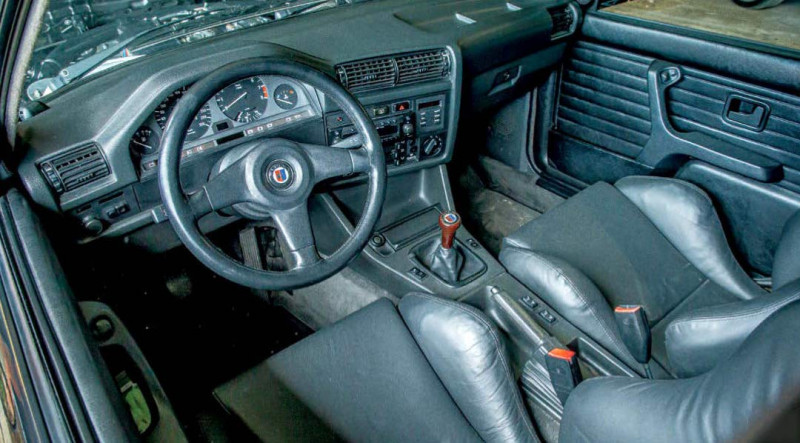
A few years ago he decided to pool all of his years of accrued knowledge into the ultimate creation. “I knew what was possible, what I could do and what I could afford…” he says, but there was one seemingly insurmountable problem in his way. The Czech equivalent of the DVLA are notoriously old-fashioned and restrictive when it comes to vehicular modifications and before he started anything knew that there was absolutely no way he could get what he wanted to build registered for the road. But there was another way to get his dream machine. “A friend of mine in Berlin was making something a little similar with an E30 to what I had in my mind… and so when it was registered with the TÜV (The German version of the DVLA) I bought it, because anything that is registered in Germany can be registered in the Czech Republic.”
Although the car was complete it was still quite far from what Viktor wanted, but most importantly it was registered with the engine he wanted, the E34 M5’s 3535cc S38B36. It was only rated at 400hp though and as he wanted much, much more than that everything from the output shaft back had to be changed, as even the M5 gearbox wouldn’t be able to cope with the power he was about to unleash into the transmission. The replacement Viktor chose is a Getrag 290 from an Alpina B10 biturbo, which can handle a massive 808lb ft of torque.
The clutch is a Sachs twin-disc race one with ceramic plates. Its either on or off so is a little hard to shuffle the car around in the garage. “It was expensive, but the main thing is that because you can’t see it… what the Czech authorities don’t know, they can’t complain about…”
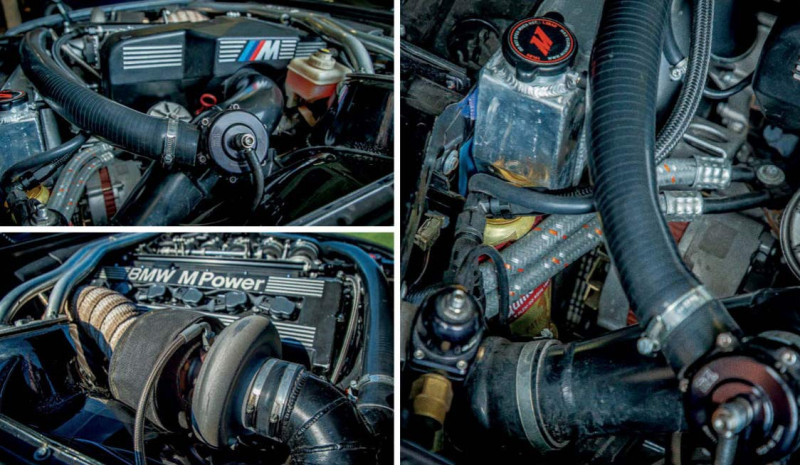
The propshaft is from a company in Berlin, customised from an E34 Alpina, as the E30 wheelbase is a little shorter. This connects to a custom diff from an E30 M3, one with a 2.79 LSD and Z3M cooling. “Normally in an LSD diff there are two clutch packs, but I had extra pair put in, which gives a stronger and more aggressive LSD activation. Now, every time I give a little gas it engages and drives both wheels. But when you come off the power it will steer.” The complicated design was made by a local friend who is a specialist in such feats of engineering.
He also needed a narrower axle to fit bigger wheels, yet still keep them under the arches, another ‘Sleeper’ innovation to keep the true power of the car hidden from the authorities. The car came from Germany with an E36 323Ti axle fitted but after looking though lots of information on the internet Viktor decided to fi t hubs from a Z4.
To keep such enormous power in check, upgraded brakes were essential as the standard set from an E30 it came with wouldn’t even last a lap no a track day before fading. It was easy enough to get bigger disks made and a local company machined a pair of dual mass disks, with aluminium hubs and steel disks, bolted together, a design intended to reduce vibration. But the calipers themselves proved a little harder. “I knew that I wanted Hartge 16-inch wheels so I needed calipers that were very strong, yet small enough to fi t inside the rims.” Some more internet research and he ordered a pair of 325mm Wilwood six-pots. “They are very tight with clearance but they fit.” But it wasn’t simply a case of bolting them on because he also needed an adapter. This he designed himself, then printed out with a 3D printer to make sure all the dimensions were correct, Only when it was perfect did he take it to a friend to get it laser cut in steel. The rear wheels have standard E36 calipers.
Those Hartge wheels are 7.5- on the front and 8.5-inches on the rear and are shod with Toyo R888Rs, which Viktor says hold the power quite well. “But it’s hard to use all power when it’s not a hot day,” he says. “In cold weather they just spin. In every gear.”
Suspension is provided by a set of K-sport shocks and springs.
And then it’s time to open the bonnet. To say that the M5 block looks shoehorned in is an understatement to say the least, but it’s the massive BorgWarner S300SX turbo stuffed in next to it that is the main point of attention. With no accommodating bulges in the bonnet, from the outside it doesn’t look such an extreme build, so you’d never guess the level of engineering that went into this car. But as Viktor explains, it was far from just a simple bolt in job.
As well as a custom ECU it also needed a custom stainless exhaust manifold, a dual wastegate system, and a Nuke fuel system as a normal fuel pump just couldn’t cope with the rate of fuel flow needed. And to cool it an oversize Mishimoto race radiator sits in front, which is helped by an electric water pump to give increased circulation more flow, even if the car is standing still.
This little beast is used only sparingly though, as with the demands of his job and a young family Viktor only has time to drive it once or twice a month in the season. “But it’s so quick, like being in a fighter jet, so it gives enough adrenaline to last for the rest of the month.” And to demonstrate this we took it for a little test drive… Crawling out of the little Bavarian village do the neighbours wouldn’t be too shocked we went to the nearest Czech equivalent of an A-road… where he put his foot down.
Trying to put the sensation of being slammed into your seat with 933hp on the other side of the dashboard isn’t that easy. It’s not supercar fast, exactly. Flooring it in a McLaren or a Ferrari, as fast as they are, there is still a sense of control threaded through the powerband. In Viktor’s little beast, the sensation is of being well out of control. The turbo gushes with a noise of a power station and the forward motion is simply brutal. Like a head-on accident in reverse.
The dot ahead quickly turned into the back of a van ahead and with his foot off the big pedal and the wastegate chatters, almost cheekily as though it knows how naughty it was to force all that air through the intake. Viktor also had a wicked smile. In my experience, scaring journalists is often a favourite past time of makers of cars like these.
The closest experience I can compare it to, is not a supercar, but a Group B rally car. I am reminded of when John Wheeler, the designer of the Ford RS200, tried, and succeeded, to scare me. That old-school analogue engine, gearbox, diff, tyres and a dearth of electronic trickery, nothing but a massive turbo and a transmission strong enough to take it.
The project isn’t quite done yet and the next thing on the to-do list is water-methanol injection. “I run it on normal fuel, so I need system which lowers the exhaust gas temperature, which is important, as with such power it has the risk of melting pistons or the turbo. And that would make me sad. I have a temp sensor and when it gets too hot it lowers the boost pressure… it says, ‘Hey, calm down.’ But it only happens on a very hot day.”
Twenty years ago Viktor started with the least powerful car in the club, now he has one of the most powerful in the country. But he doesn’t know for sure. “It’s a little hard to tell who officially has the most powerful car as it depends on things like the ambient temperature and what fuel you have. On the testing rig, once I had 900hp, 933 a couple of times, and another was 908.”
With 933bhp, it seems that the round figure of 1000bhp is tantalisingly close, but Viktor is not interested in such goals. “I don’t need numbers. For me the car is only about the feeling and right now the feeling is great!”
TECHNICAL DATA 900hp E30
- ENGINE: S38B36 engine Borg-Warner turbocharger, custom stainless exhaust manifold, dual wastegate system, Nuke gasoline system, custom ECU, Alpina 290 gearbox from Alpina B10 biturbo, 808lb ft torque, Sachs twin-disc race clutch with ceramic plates, custom centre shaft, 2,79 LSD with Z3M cooling.
- CHASSIS: 5x120 conversion, K-sport suspension, 325mm custom front discs with Wilwood brake calipers, rear E36 brakes Mishimoto race cooler and Craig Davies electric water pump.
Most importantly it was registered with the engine he wanted – the E34 M5’s S38B36


